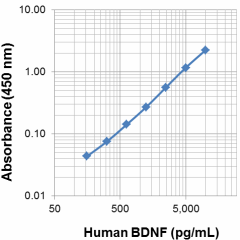- Regulatory Status
- RUO
- Other Names
- Brain-derived neurotrophic factor, ANON2, BLUN2
- Ave. Rating
- Submit a Review
- Product Citations
- publications

| Cat # | Size | Price | Quantity Check Availability | Save | ||
|---|---|---|---|---|---|---|
| 759709 | 4 pack | £65 | ||||
Brain-derived neurotrophic factor (BDNF) is the second member of the NGF family of neurotrophic factors (neurotrophins) that includes nerve growth factor (NGF), neurotrophin-3 (NT-3) and neurotrophin-4/5 (NT-4/5). BDNF shares approximately 55% amino acid identity with other family members. The amino acid sequence of mature BDNF is identical in all mammals examined. All neurotrophins are noncovalently linked homodimers and initially produced as proneurotrophins. These proneurotrophins have distinct biological activity different from their mature counterparts. Mature BDNF promotes the survival and differentiation of selected neuronal populations of the peripheral and central nervous systems during the development. BDNF participates in axonal growth, pathfinding and in the modulation of dendritic growth and morphology. BDNF is also a major regulator of synaptic transmission and plasticity at adult synapses in many regions of the CNS. High levels of expression of BDNF have been detected in the hippocampus, cerebellum, fetal eye and placenta. BDNF binds with high affinity and specifically activates the TrkB tyrosine kinase receptor.
Product DetailsProduct Details
- Source
- Human BDNF, amino acids His129-Arg247 (Accession# P23560) was expressed in CHO cells.
- Molecular Mass
- The 119 amino acid recombinant protein has a predicted molecular mass of approximately 13.5 kD. The DTT-reduced and non-reduced proteins migrate at approximately 14.5 kD by SDS-PAGE. The predicted N-terminal amino acid is His.
- Purity
- >95%, as determined by Coomassie stained SDS-PAGE.
- Formulation
- Lyophilized in sterile-filtered PBS, pH 7.2, containing 1% BSA, 0.09% sodium azide, and protease inhibitors.
- Concentration
- Lot-specific (to obtain lot-specific concentration and expiration, please enter the lot number in our Certificate of Analysis online tool.)
- Storage & Handling
- Unopened vials can be stored between 2°C and 8°C until the expiration date. Prior to use, reconstitute the lyophilized powder with 0.2 mL of PBS containing a carrier protein (e.g., 1% BSA, protease free), pH7.4. Re-cap vial, vortex. Allow the reconstituted standard to sit at room temperature for 15 minutes, vortex again to mix completely. The reconstituted standard stock solution can be aliquoted into polypropylene vials and stored at -70°C for up to one month. Do not re-use diluted standards. Avoid repeated freeze/thaw cycles.
- Application
-
ELISA - Quality tested
- Recommended Usage
-
Each lot of this protein is quality control tested by ELISA assay. For use as an ELISA standard, a standard curve comprised of doubling dilutions from 156.3 to 10,000 pg/mL is suggested. It is recommended that the reagent be titrated for optimal performance for each application.
- Application Notes
-
This human BDNF protein is useful as a standard for a human BDNF sandwich ELISA, using unlabeled A15062G antibody (Cat. No. 536702) as capture and biotinylated A15062F antibody (Cat. No. 536804) as detection.
Antigen Details
- Structure
- Noncovalently linked homodimer
- Distribution
-
Ubiquitous with high levels in peripheral tissues including prostate, placenta, pancreas, heart, kidney, pituitary gland, lung, and testis.
- Function
- Supports the survival of sensory and sympathetic neurons, and also dopaminergic midbrain neurons.
- Interaction
- Sensory neurons, sympathetic neurons, midbrain dopaminergic neurons.
- Ligand/Receptor
- TrkB
- Biology Area
- Cell Biology, Neuroscience, Stem Cells, Synaptic Biology
- Molecular Family
- Cytokines/Chemokines, Growth Factors
- Antigen References
-
- Baloh RH, et al. 1998. Neuron. 21:1291
- Masure S, et al. 1999. Eur. J. Biochem. 266:892-902.
- Gardell LR, et al. 2003. Nat. Med. 9(11):1383-9.
- Honma Y, et al. 2002. Neuron. 35:267-82.
- Banerjee A, et al. 2012. PLoS One 7(11):e50098.
- Wong LE, et al. 2015. Proc. Natl. Acad. Sci. USA 112:6170-5.
- Zhang M, et al. 2016. Oncotarget. 7:3267-82.
- Gene ID
- 627 View all products for this Gene ID
- UniProt
- View information about BDNF on UniProt.org
 Login / Register
Login / Register 














Follow Us